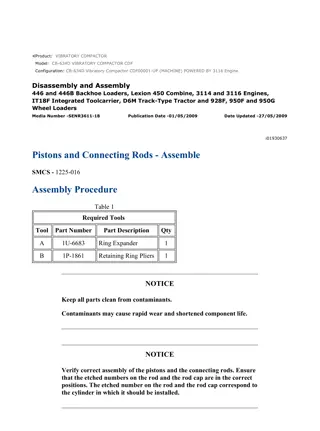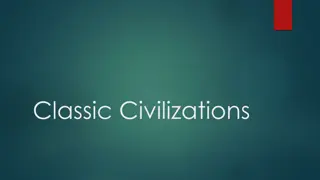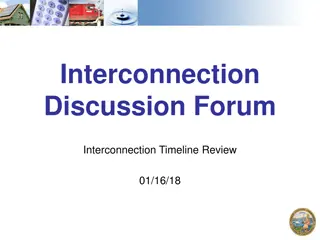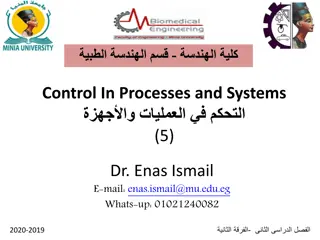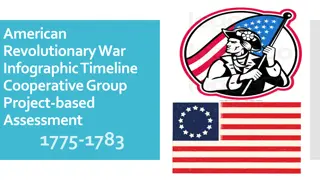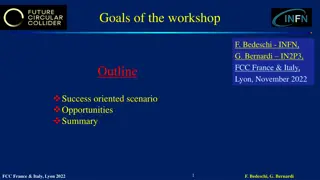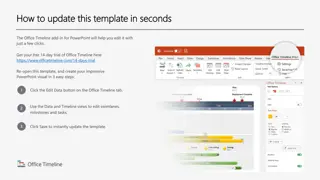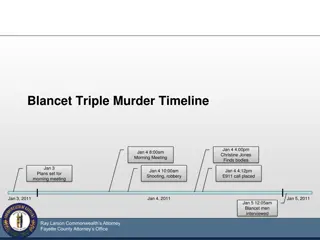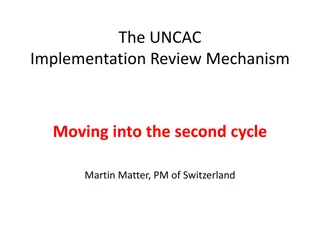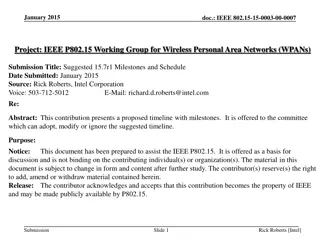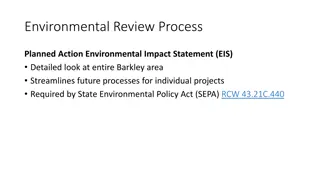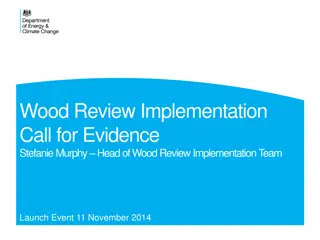CDF Review Responses and Timeline Analysis
Analysis and overview of the CDF review responses from the PDS Management Council face-to-face meeting held in Los Angeles on February 5, 2016. The timeline covers the PDS4 CDF archiving process, document releases, comment statistics, and reviewer details regarding the MAVEN mission. Various documents, peer reviews, and metadata related to CDF and PDS4 labeling are discussed, highlighting the progress and status of the review process.
Download Presentation

Please find below an Image/Link to download the presentation.
The content on the website is provided AS IS for your information and personal use only. It may not be sold, licensed, or shared on other websites without obtaining consent from the author.If you encounter any issues during the download, it is possible that the publisher has removed the file from their server.
You are allowed to download the files provided on this website for personal or commercial use, subject to the condition that they are used lawfully. All files are the property of their respective owners.
The content on the website is provided AS IS for your information and personal use only. It may not be sold, licensed, or shared on other websites without obtaining consent from the author.
E N D
Presentation Transcript
CDF Review & Responses J. Mafi & T. King PDS Management Council Face-to-Face Los Angeles, CA February 5, 2016
Overview PDS4 CDF archiving timeline Comment Overview & Statistics Select Issues
PDS4 CDF Archiving Timeline 22 Jan 2010 07 May 2013 10 Jun 2013 26 Jul 2013 18 Nov 2013 13 Mar 2014 Jul-Sep 2014 Jan-Feb 2015 26 Feb 2015 Apr-Sep 2015 May-Jun 2015 Jun-Jul 2015 8 Jun 2015 MAVEN initial contact (MAVEN PSG, Boulder) PDS4 V1.0.0.0 MC Telecon: CDF to be described using PDS4 Array objects PDS4 CDF White Paper MAVEN launch MAVEN PDS4 archive CDF constraints document MAVEN preliminary peer reviews PDS CDF Tiger Team Review CDF-A Specification document MAVEN delta peer reviews PDSMC MAVEN CDF review (2015-04-21/02) MAVEN Release #1 How to Guide for Reading PDS4 Labeled Array Data
Comment Timeline Comment Count 35 Document Releases Constraints CDF-A How to 30 MVN Prelim. MVN Delta Peer Reviews TT MC 25 20 15 10 5 0 Jan-14Jan-14 Mar-14 Apr-14 May-14 May-14 Jun-14Jul-14 Aug-14 Sep-14 Oct-14 Nov-14 Dec-14 Jan-15 Feb-15 Mar-15 Apr-15 May-15 Jun-15Jul-15 Aug-15 Sep-15 Oct-15 Nov-15 Dec-15
CDF Review Commenters MAVEN Archive Peer Reviews MAVEN instrument/project personnel Science data users NASA Space Physics Data Facility (SPDF) PDS Internal Review DDWG PDS MC CDF Tiger Team
CDF Review Comment Overview Type Existential Archive Documentation Context CDF Tiger Team MAVEN Peer Reviews PDS CDF Documentation Reviews PDSMC CDF Review MAVEN Peer Reviews MAVEN Peer Reviews MAVEN Peer Reviews PDSMC CDF Review CDF Tiger Team MAVEN Peer Reviews PDSMC CDF Review CDF Metadata CDF Data PDS4 Labels PDS4 Tool Support
CDF Review Comment Status Statistics Superseded 0 Type Existential Archive Documentation CDF Metadata CDF Data PDS4 Labels PDS4 Tool Support Unclassified TOTAL 5 Addressed 0 Open 0 Closed 5 25 7 3 1 36 29 5 23 1 0 1 4 0 5 0 0 0 34 5 29 0 3 0 0 3 10 3 6 2 21 133 TOTAL 82 8 16 3
MAVEN Review Comment Row #41 Context MAVEN Preliminary Reviews Comment Subject Source Date Reviewer Status PDS4 LabelsLPW Prelim. 8/12/2014 Martin Addressed Review There is a lot more product metadata in the CDF labels than is provided in the PDS4 labels. If we are really using PDS4 to create archive products that can be used hundreds of years from now then all the metadata buried in the CDF labels needs to be exposed in the PDS4 labels. Otherwise, this is not a PDS4 archive, it is a CDF archive. Possibly the detailed metadata could be extracted from the CDF's and put into some kind of PDS4 supplementary table. Expanded content of PDS4 labels to include all relevant CDF metadata. Response
MAVEN Review Comment Row #42 Context MAVEN Preliminary Reviews Comment Subject Source Date Reviewer Status PDS4 LabelsLPW Prelim. 8/12/2014 Martin Addressed Review Regarding all the array products. From the labels there is really no way to know how the array components relate to each other. Each array could be completely independent. It seems like there should be some kind of explicit association that indicates that the several 1d array elements correspond (time[0] goes with density[0]). Developed Discipline_Area.Particle_Observation class to provide associations between array objects. Response
MAVEN Review Comment Row #64 Context CDF Constraints Document Comment Subject Source Date Reviewer Status PDS4 Labels email 9/16/2014 Simpson Open Only CDF 3.4 HEADER objects are allowed (not 3.5); if you don't think that's important, I'm willing to let it go. Response
MAVEN Review Comment Row #84 Context MAVEN Preliminary Reviews Comment Subject Source Date Reviewer Status Archive Documentation email 2/5/2015 Wilson Addressed CDF software requires a CDF leapseconds file (not the same as an SPICE LSK kernel), the format of which is specified by SPDF. To insure accurate results data users must use the same CDF leapseconds file that was used by the data provider. Availability of current leapseconds files is dependent upon SPDF. MAVEN used SPICE LSK s for their leapsecond calculations. LSK used is identified in both the PDS4 label and CDF metadata. Response
MAVEN Review Comment Row #88 Context MAVEN Preliminary Reviews Comment Subject Source Date Reviewer Status Archive Documentation email 2/5/2015 Wilson Open Have the order of multidimensional data have the same dimensional order in both Matlab and IDL. Really this is a row- major/column-major issue I think... I can't test to confirm this one. When I peer-reviewed the Maven CDF data using Matlab my dimensions were in the reverse order to those listed in the SIS (seemed they used IDL) - was that a typo or a row/column issue? We believed a row/column issue in my chosen reader (Matlab) of CDF files at the time. This issue needs to be included in the archive documentation. Response
CDF Tiger Team Finding Row #89 Context CDF Tiger Team Comment Subject Source CDF Tiger Team Report Date Reviewer CDF Tiger Team Status 2/9/2015 Addressed MAVEN archives should include CDF files with PDS4 labels as PPI has designed and that conform to the constraints that PPI has defined (PPI white paper How To Create PDS4 Compatible File in the CDF Format, rev. 2014-10-15). This approach has been followed for all of the MAVEN CDF data sets. Response
CDF Tiger Team Finding Row #90 Context CDF Tiger Team Comment Subject PDS4 LabelsCDF Tiger Source Date Reviewer CDF Tiger Team Status 2/9/2015 Addressed Team Report The PDS4 labels should be debugged and improved (e.g., to better define relationships between arrays). PDS4 label debugging was accomplished by means of the MAVEN Delta Peer Reviews, and PDSMC MAVEN CDF Review. Improvements included the creation of the Particle_Observation, and Parameter objects Response
CDF Tiger Team Finding Row #91 Context CDF Tiger Team Comment Subject Source CDF Tiger Team Report Date Reviewer CDF Tiger Team Status 2/9/2015 Closed There was not a consensus on whether MAVEN CDF files should be converted to another format that would be the primary archive product, making the CDF files a supplemental product. The approach taken with the MAVEN archive has been to used the CDF data as the primary archive, describing them as binary array objects. Response
CDF Tiger Team Finding Row #92 Context CDF Tiger Team Comment Subject Source CDF Tiger Team Report Date Reviewer CDF Tiger Team Status Existential 2/9/2015 Closed Even if the CDF file can be described by a PDS4 label, it would still violate the basic simplicity principle of PDS4. Response
MAVEN Review Comment Row #104 Context MAVEN Delta Reviews Comment Subject Source Date Reviewer Status SWIA Delta Review Archive Documentation 4/29/2015 Martin Addressed It would be nice to have a layperson description of the significance of the different data collections. They all look about the same to me in the autoplot displays. Sections were added to the SWIA and SWEA SIS documents to address this recommendation. Response
PDSMC CDF Review Row #120 Context PDSMC CDF Review Comment Subject Source Date Reviewer Status Gordon Addressed PDS4 Labels email 6/9/2015 1D-1 field arrays should not be identified in the labels (assuming my understanding is correct, and these are all single valued for the entire file). For someone using the XML label and software other than CDF- A, that information is given as an attribute in the labels. Rather than list those arrays in the XML label, consider them as part of the intervening embedded headers. "Single-element array" values have been added to the PDS4 labels as metadata and are not defined as array objects within the data files. Response
PDSMC CDF Review Row #121 Context PDSMC CDF Review Comment Subject Source Date Reviewer Status PDS4 Labels email 6/29/2015 Gordon Addressed <name>dindex</name> <description>Deflection Index for CDF compatibility</description> There must be a better way to describe this array. You should be describing it in the XML label for non CDF users. The array has values [1,2,3,4]; it is used as an array axis for multiple arrays, and I still do not see an association between it's values and something more substantial, like deflection angle values. The PDS4 labels for these products have been modified to use the appropriate multi-dimensional array for describing the data array axes. Response
PDSMC CDF Review Row #122 Context PDSMC CDF Review Comment Subject Source Date Reviewer Status 6/29/2015 Gordon Addressed PDS4 Labels email <Array> <name>theta_coarse</name> This array has two axes, of lengths 4 and 48, both with axis names of "index". Same arguments as above; for a non-CDF user trying to understand the data, this appears unnecessarily obscure. The value "index" was used in cases where "the parameter is itself an independent variable". However, since the axis variable references have been moved out of the File_Area_Observational and into the Discipline_Area, the approach is now to simply use a descriptive value for the axis_name. Response
PDSMC CDF Review Row #123 Context PDSMC CDF Review Comment Subject Archive Documentation Generally if you have a 3D array, you need values for three axes, for a 4D array, values for four axes would seem to be sufficient. So why the "...and, possibly, a face plane"? the overview [says] the primary data is in"... 3 Dimensional arrays with the axis of the look directions (Phi and Theta) and energy level..." with time as a fourth dimension. However it appears that Theta is not a axis of the 4D arrays, it as a face of the 4D arrays which really have axes of Phi, dindex, Energy, and Time. The SWIA data arrays are 4-D arrays, with axes: energy, 2 angles (theta, phi), and time. However, the theta angle is itself dependent upon energy, making it a 2-D array which aligns with the energy-theta plane of the data array. Source Date Reviewer Status email 6/29/2015 Gordon Addressed Response





